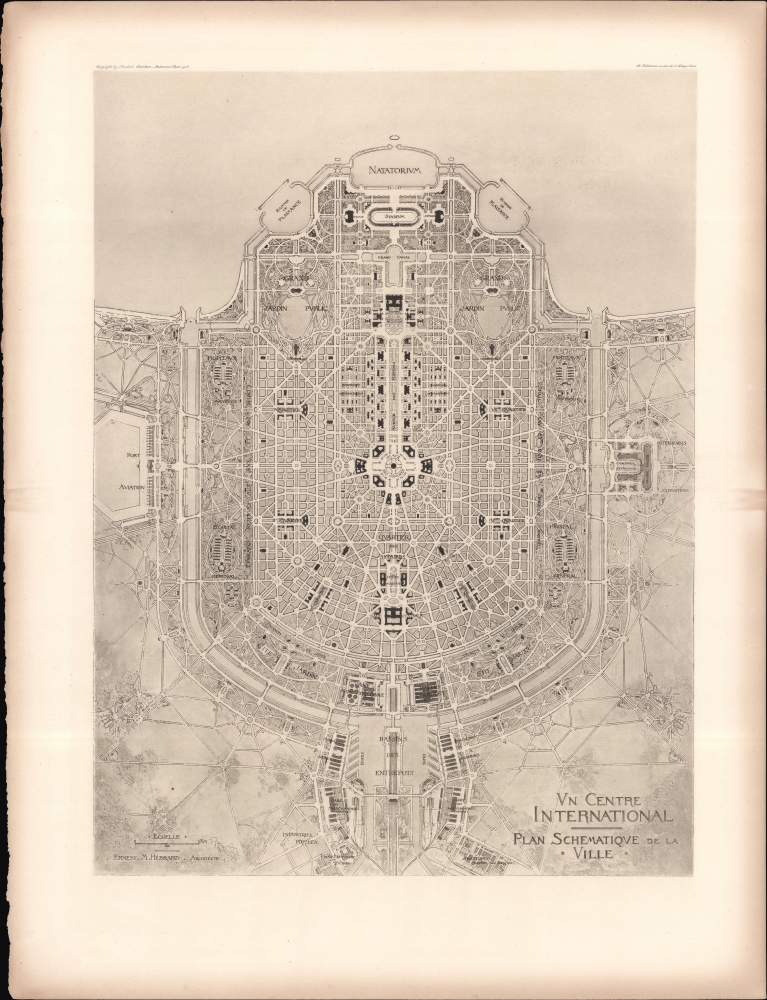Digital Image: 1913 Hebrard City Plan of a Utopian 'International Center'
CentreInternational-hebrard-1913_d
Title
1913 (dated) 19 x 14 in (48.26 x 35.56 cm)
Description
FOR THE ORIGINAL ANTIQUE MAP, WITH HISTORICAL ANALYSIS, CLICK HERE.
Digital Map Information
Geographicus maintains an archive of high-resolution rare map scans. We scan our maps at 300 DPI or higher, with newer images being 600 DPI, (either TIFF or JPEG, depending on when the scan was done) which is most cases in suitable for enlargement and printing.
Delivery
Once you purchase our digital scan service, you will receive a download link via email - usually within seconds. Digital orders are delivered as ZIP files, an industry standard file compression protocol that any computer should be able to unpack. Some of our files are very large, and can take some time to download. Most files are saved into your computer's 'Downloads' folder. All delivery is electronic. No physical product is shipped.
Credit and Scope of Use
You can use your digial image any way you want! Our digital images are unrestricted by copyright and can be used, modified, and published freely. The textual description that accompanies the original antique map is not included in the sale of digital images and remains protected by copyright. That said, we put significant care and effort into scanning and editing these maps, and we’d appreciate a credit when possible. Should you wish to credit us, please use the following credit line:
Courtesy of Geographicus Rare Antique Maps (https://www.geographicus.com).
How Large Can I Print?
In general, at 300 DPI, you should at least be able to double the size of the actual image, more so with our 600 DPI images. So, if the original was 10 x 12 inches, you can print at 20 x 24 inches, without quality loss. If your display requirements can accommodate some loss in image quality, you can make it even larger. That being said, no quality of scan will allow you to blow up at 10 x 12 inch map to wall size without significant quality loss. For more information, it is best consult a printer or reprographics specialist.
Refunds
If the high resolution image you ordered is unavailable, we will fully refund your purchase. Otherwise, digital images scans are a service, not a tangible product, and cannot be returned or refunded once the download link is used.
Cartographer S
Ernest Hébrard (1875 - 1933) was a French architect, archeologist, and urban planner best known for his plans for reconstructing Thessaloniki after a great fire in 1917 and for his contributions to designing sites in French Indochina. Hébrard studied at the École des Beaux-Arts in Paris, then at the Académie de France in Rome, where he undertook research on Diocletian's palace at Split (Croatia), which is still considered authoritative on the subject. Around this time, he and others associated with the Musée social developed an interest in urban planning, and Hébrard went on to become a founding member of the French Society of Urban Planners (Société française des urbanistes) in 1911. During the First World War, he was assigned as an archaeologist with the French Army of the East stationed at Thessaloniki. When that city suffered a terribly destructive fire in 1917, Hébrard was commissioned by the Greek Prime Minister (who favored a modern city plan) to redesign Thessaloniki. Hébrard and his colleagues completely reworked the city plan, focusing on a number of ancient ruins but otherwise replacing narrow and winding historic streets with wide, symmetrical boulevards. Afterward, he was made head of the Indochina Architecture and Town Planning Service based in Hanoi. He helped lay out the mountain resort town of Da Lat and colonial neighborhoods in other cities. Hébrard also developed a unique syncretic architectural style that was employed in several government buildings, schools, and churches, including the Vietnam National Museum of History (Viện Bảo tàng Lịch sử Việt Nam) and the Cửa Bắc Church in Hanoi. He returned to Paris in 1931 and died two years later, and was buried at Père-Lachaise. More by this mapmaker...
Charles Wittmann (1876 - 1953) was a painter and printer based in Paris. The son of the painter and sculptor Ernest Wittmann, he studied at the École des Beaux-Arts in Paris starting in 1894, becoming a student of Eugène Carrière and Gustave Moureau. As a painter, Wittmann was primarily known for his lively depictions of Paris in the Belle Époque period. He appears to be the same Charles Wittmann who succeeded Charles Chardon as the head (chef de l'atelier) of the Chalcographie du Louvre in 1896, after having inherited Chardon's printshop in 1890 (perhaps with his father or an older brother). Learn More...

